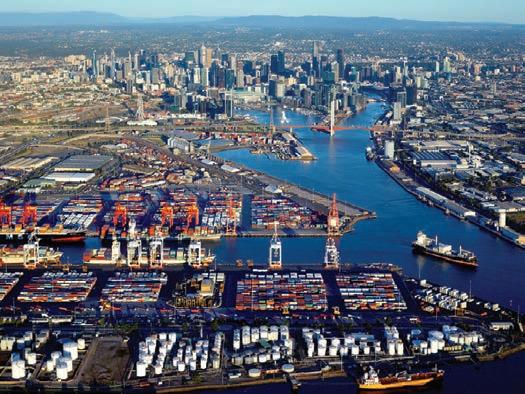
9 minute read
News
MAJOR SYDNEY METRO TUNNELLING PACKAGE AWARDED
QUEENSLAND GOVERNMENT TO FUND FASTER RAIL PROJECT AHEAD OF OLYMPICS
A consortium between Gamuda Australia and Laing O’Rourke has been appointed by the New South Wales Government to deliver the $2.16 billion Western Tunnelling Package for the Sydney Metro West project.
The project will deliver a new direct, 24-kilometre underground rail connection between the CBDs of Parramatta and Sydney, with stations confirmed at Westmead, Parramatta, Sydney Olympic Park, North Strathfield, Burwood North, Five Dock, The Bays, Pyrmont and Hunter Street in the Sydney CBD.
The project’s tunnelling work has been structured into three packages, with the Central Package awarded to an Acciona and Ferrovial Joint Venture in July last year.
The remaining two tenderers – John Holland, CPB Contractors and Ghella Australia Joint Venture and Gamuda and Laing O’Rourke Joint Venture – were bidding for the Western Tunnelling Package.
Sydney Metro has also begun the process to appoint its third major tunnelling contractor for the Eastern Tunnelling, with three consortia shortlisted earlier this year. This contract for tunnelling between The Bays and Hunter Street in the Sydney CBD is expected to be awarded by late 2022.
The scope for Western Package includes excavation and construction of nine kilometres of twin tunnels between Westmead and Sydney Olympic Park.
Sydney Metro West will create more than 10,000 direct new jobs and 70,000 indirect jobs, with many of these jobs generated by this major contract.
Early works will commence on the Western Tunnelling Package within weeks, with tunnelling scheduled to start late 2023.
Artist’s impression of the Westmead metro station.
The Queensland Government has committed an just over $1.1 billion to deliver faster rail services between Brisbane, Logan, Beenleigh and the Gold Coast.
As the first piece of Olympics transport infrastructure, Premier Annastacia Palaszczuk said the project would see more tracks laid and level crossings removed to support faster, more frequent train services.
The investment follows the Federal and Queensland governments’ previous commitment of $356 million (on a 50:50 funding arrangement) in pre-construction funding for the project.
A recently completed business case puts this project at a total cost of approximately $2.6 billion.
The Logan and Gold Coast faster rail will double the capacity of the Gold Coast rail line and deliver seven station upgrades and two station relocations to improve accessibility, safety and amenity, including platform straightening, and new pedestrian bridges as part of the works.
This infrastructure funding will also complement the Cross River Rail project, which will provide a greater number of public transport routes to busy venues around Brisbane.
Currently, trains between Kuraby and Beenleigh share a single track in each direction, limiting the number of peak services that can run.
Since March 2018, Infrastructure Australia has included ‘Gold Coast rail line and station improvements: Kuraby to Beenleigh’ in the Infrastructure Priority List and the Southeast Queensland Regional Transport Plan identifies an upgrade of the Kuraby to Beenleigh section of the rail network as a priority action.
The project will see fast rail services added between Brisbane, Logan, Beenleigh and the Gold Coast.



TUNNELLING STARTS FOR THE WEST GATE TUNNEL

The Federal Government has established the National Intermodal Corporation (NIC), which has been set up to support the delivery and operation of intermodal terminals as part of the $14.5 billion Inland Rail project.
It announced it would expand the Sydney-based Moorebank Intermodal Company’s mandate to turn it into the NIC and build intermodal terminals in Melbourne and Brisbane.
“National Intermodal’s task is to create an interconnected network of terminals that provide fair and equal access for all above-rail operators,” Erin Flaherty, Chair of the Moorebank Intermodal Company says.
“We will work closely with industry to increase the movement of freight by rail as it provides a cost effective and more sustainable transport mode for many customers,” she adds.
“National Intermodal will work with the federal, state and local governments, the Australian Rail Track Corporation, aboverail operators and industry to ensure commercially sustainable, fit-for-purpose terminals are delivered.”
The Federal Government says its investments in the terminals will improve “freight outcomes” and “productivity” as well as increase competition in the sector by ensuring open-access arrangements across the network.
Complementary intermodal terminals in Melbourne and Brisbane will further support the Federal Government’s investment in Inland Rail, which will create more than 21,500 jobs at the peak of construction with a potential boost of more than $18 billion to GDP during construction and over the first 50 years of operation.
These intermodal terminals will play a role in the consolidation, storage and transfer of freight between rail and road at the beginning and end of each rail journey.
The terminals will also provide connectivity to ports, regional networks and other capital cities and locations.
The Inland Rial project is Australia’s largest freight rail infrastructure project and will consist of over 1700 kilometres of rail connecting Melbourne and Brisbane via regional Victoria, New South Wales and Queensland. Construction on the Inland Rail Project commenced in 2018 and is anticipated to be completed in 2027.
The largest tunnel boring machine (TBM) in the Southern Hemisphere has started digging the West Gate Tunnel in Melbourne.
The massive TBM, named Bella, was sent on its journey under Melbourne’s western suburbs to build the alternative to the West Gate Bridge.
The West Gate Tunnel Project will deliver an alternative to the West Gate Bridge in Melbourne. The Corporation will support the delivery and operation of intermodal terminals for Inland Rail.
It is now working its way through the earth below Yarraville and will travel for 18 months, excavating the four-kilometre outbound tunnel that will meet up with the West Gate Freeway in Altona North.
The second TBM, named Vida, will soon begin work on the 2.8-kilometre inbound tunnel.
The TBMs are named after Bella Guerin and Vida Goldstein.
The TBMs are 15.6 metres in diameter and 90 metres long, weighing in at 4000 tonnes each, which is about the same as 20 Boeing 747 airplanes. They are equipped with a state-of-the-art computerised navigation system and will dig through an average of nine metres per day. They have been specifically chosen for their ability to work deep underground with almost no disturbance above ground for traffic, businesses and residents.
The TBMs are being piloted by a highly trained specialist crew who will work around the clock while the tunnel is being built. While the TBMs bore through the earth, a mobile factory behind them will install massive concrete rings to form the structural and waterproof lining of the tunnel.
Crews of up to 20 people will then work to build the road surface and install electrics, ventilation and safety systems.
Excavated soil will be taken to a specially built facility operated by HiQuality in Bulla.
The TBMs have been through a thorough testing and commissioning phase within the project site in Yarraville to ensure they’re working effectively before commencing their journey.
A joint venture consisting of John Holland and CPB Contractors is the subcontractor delivering the project.



REMAINDER OF THE OUTBACK WAY TO BE SEALED
PORT OF MELBOURNE TO EXPAND CAPACITY

The Western Australian Government has partnered with the Commonwealth Government to seal the remainder of Outback Way as part of a $678 million project to deliver a new strategic transport and tourism route with the eastern states.
The Outback Way is made up of seven interconnecting roads from Winton, Queensland through to Alice Springs in the Northern Territory and finishing in Laverton, Western Australia. The track cuts right through the middle of Australia and totals 2800 kilometres.
The Federal Government has allocated $400 million to complete the 872-kilometre seal through Western Australia, with the WA Government committing a further $100 million towards the project. The remainder of the funding will help seal the road in the Northern Territory and Queensland.
This additional funding builds on the $330 million invested by the Federal Government since 2013 to seal over 600 kilometres of Outback Way.
In Western Australia, about $52 million has so far been spent to upgrade the route, with an additional $112 million already allocated for works over 147 kilometres through to 2025-26.
Deputy Prime Minister and Minister for Infrastructure, Transport and Regional Development, Barnaby Joyce, said $124 million of the fund will be spent on upgrades in the Northern Territory, creating 442 jobs.
“These upgrades will spark new opportunities for industries along the route, including the critical earth precincts north of Alice Springs, the gold precincts around Laverton and the massive beef industry, while ensuring communities and people on the corridor
The Outback Way is made up of seven interconnecting roads from Queensland to Western Australia.
have better access to supplies,” the Deputy Prime Minister said.
The road is critical in providing access to remote Aboriginal communities, with sealing to improve access to health and other services, while opening up rich mineral deposits east of Laverton. Work on the project is also providing ongoing employment and training opportunities for local Aboriginal people.
The project will see a new road link to the eastern states, which will provide a new freight and tourism route.
The entire 872-kilometre connection within WA will be sealed over the next seven years.
Port of Melbourne has awarded a contract for development works at Webb Dock East to reduce port congestion and accommodate larger ships at the port.
The works will help reduce congestion and accommodate larger ships at the port.
The contract for the works has been awarded to Fitzgerald Constructions Australia and involves demolishing a redundant section of concrete and extending the quay line by 71 metres.
When completed in the third quarter of 2023, the development will allow the port to have two ships berth at the same time, improving efficiency at Australia’s largest container and general cargo port.
Port of Melbourne CEO Saul Cannon said the project was an important part of a 30-year investment strategy, designed to create a more efficient and productive port that helps to strengthen Victoria’s economy.
“Now more than ever, we need to make sure we get essential goods delivered to hospitals, businesses, schools and homes.
“We are seeing a rising number of larger vessels calling at the port and our current infrastructure at Webb Dock East at times does not allow for two ships to berth at the same time. For example, this project will enable two larger vessels to berth at the same time at this part of the port, reducing wait times for the ships to dock,” he said.
Webb Dock East was designed as a two-berth terminal. This project will restore Webb Dock East’s intended design capacity.
The Webb Dock East project is the third of nine projects that form the 2050 Port Development Strategy – a blueprint for ensuring the port stands ready to accommodate the needs of a growing city and continues to make a major contribution to Victoria’s social and economic prosperity.











